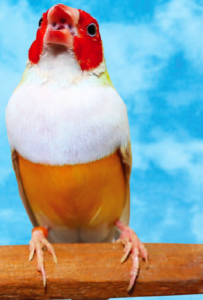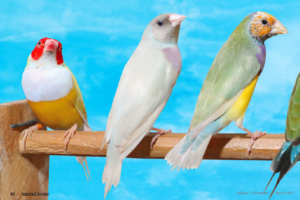Get to know this colorful and charming bird.
Aptly also called the rainbow finch, the Lady Gouldian Finch originated in Australia. A glance will tell you why it’s popular; it’s small, utterly cute, and colorful. Many other finches are also attractive, but breeder and fancier Hansel Sy says, “Finches are nice to look at, and they look clean.”
Handle with Care
Hansel explains that there aren’t too many finches in the Philippines to begin with; the birds are very expensive despite their small size. But, being small birds, small mistakes can kill them, he cautions. It’s worth mentioning that Googling the breed will include some sources that will say the bird is popular because it is easy to raise. Responsible breeders have carefully reserved judgment on this but their experience—and Hansel’s—have taught them that the Gouldian finch is not a bird for a casual or beginning bird keeper or fancier.

Finches of different subspecies have different temperaments, Hansel cautions, and the Gouldian is one of the more delicate of its kind. You can, however, expect them to live up to 10 years with care. For one thing, these birds are not to be handled on a regular basis as they are quite sensitive to stress, he says. They are also easily scared, and should not always be disturbed.
In short, they are creatures best appreciated from a distance; appreciating the Gouldian finch requires patience, imagination, and the ability to leave the bird alone. Likely the fact that it does not have a particularly sweet song compared to other birds will make the latter piece of advice fairly easy—in fact, it is mostly silent.
How do you know a Gouldian finch is healthy? Hansel says their feathers must be brilliant. Watch out for diarrhea and keep the bird from getting cold; you’ll know it’s cold if its feathers are standing up. If it is sick, put it in a ‘hospital cage’ made of wood that’s draft-proof; Hansel explains that such boxes have screens or wire and have a light inside to heat the birds.
Currently classified by the International Union for Conservation of Nature (IUCN) as “endangered in the wild” since 1992, the Gouldian finch’s population is declining, and it’s the serious hobbyists who are helping conservationists and scientists save the species. Hansel says he’s been fascinated with birds since childhood; back then, all he had access to were lovebirds. He considered them to be very colorful and cared for them; later, he saw finches such as star finches in magazines and on the Internet. That’s what helped expand his appreciation of the hobby.
Drawing from Experience
Hansel’s experience has taught him much about raising this delicate creature, which does not like to be startled. He credits a friend and fellow fancier, Raffy Yap, for teaching how to keep them. Along the way, he’s learned a few other things, including the fact that Gouldian finches tend to be scared easily, so it’s best to leave them alone. “Don’t disturb them a lot,” he cautions.

Having plants nearby also helps; they appreciate having foliage nearby. “They like shaded environments not exposed to sun; they like the outdoors,” Hansel says.
But as with any other bird, owners need to ensure that their cages are always clean so that these will not attract mice, rats, or other vermin that can prey on the Gouldian finch. “You must study them first,” Hansel insists. “Don’t take the bird lightly. You can join finch clubs to learn more about them. But be sure you’re serious about it.” Unlike other, hardier bird species, the Gouldian finch requires that the owner be familiar with the vagaries of birdkeeping.
You can’t wing your way (apologies for the pun) through caring for a Gouldian finch. For one thing, their temperature preference is “just right,” Hansel explains; neither too cold nor too hot, owners need to be alert to when the weather is too hot (so that they can bring the birds indoors) or when it’s too cold. While the Gouldian finch is normally a seed eater, preferring grass seeds, those kept by fanciers, Hansel explains, has a diet that includes chicken eggs mashed with bread crumbs. They can also have fresh leafy greens.
For a treat, you can feed them flatworms, Hansel says. Gouldian finches are known to be insect eaters in the wild during mating season, after all. “You can buy the flatworms from aquatic suppliers. Just feed a little; they eat those quickly!” He also advises that the birds be given Vitamin C; a powder can be bought from veterinarians or veterinarian supplies which can be dissolved in their water. They particularly need this when the weather is cold, and daily, they need clean water daily.
The Challenge of Breeding

Gouldian finches like company, and ideally should be kept in, at the minimum, pairs. When mating, the male Gouldian finch does an interesting courtship dance that shows off its colors. Once mated, a female lays from 4-8 eggs (with the number decreasing as the bird ages), and normally, both male and female brood the eggs.
The interesting part, he says, is that even the males sit on nests; they are parental in nature. And paired mature males can care for young together; in 8 – 12 months, Gouldian finches are mature, Hansel explains. Pairs tend to bond together and breeders do not recommend that they be separated.
It can be somewhat different when the birds aren’t in the wild. “It’s better if they are compatible;
they’re like people, with individual temperaments. The happier they are together, the better,” Hansel says when asked about what it’s like to breed the Gouldian finch. But mating is just the first step. There is a behavior in which one of the parents tosses a chick away; this is when a breeder knows it’s time to use a foster parent.
“We have foster parents for the birds when we breed them; we use the Bangalesh or society finch,” he explains.
When the Gouldians have eggs and have difficulty brooding, the breeders give these to the foster parent birds to care for. While other bird species also require foster parents for their young, Hansel says it’s a breeder art to find them. “The Gouldian is a very quiet bird; just feed it well, keep its environment clean…Don’t hold or play with them this will stress them out and can kill them,” Hansel sums up.

Quick Facts
Scientific Name: Erythrura gouldiae
Native habitat: Tropical savannah woodlands
Migratory behavior: Nomadic within 40 square kilometers; they follow food and water sources
Estimated population: About 100,000 birds worldwide
Appearance: Brightly colored, featuring black, green, purple, red, and yellow; mutations like the ones featured here show even more colors. Males tend to be brighter-colored than the females. Color mutations include dilute, yellow-bodied, blue-bodied, silver, and pastel.
Size: About 5 inches from head to tail
Found at
• Bastion Hills, next to the town of Wyndham in eastern Kimberley, Australia (biggest concentration observed)
• Northern Australia, from the Cape York Peninsula through north-west Queensland
Did you know?
• First described by British ornithological artist John Gould in 1844, he named the finch after his wife Elizabeth.
• Newly hatched Gouldian finches, which are born bald (feathers do not appear until they’re about two weeks old) have light-reflective (not luminescent as claimed by some) markings/nodules in and around their beaks.
• In the 1989 “Batman” movie, the Catwoman character played by Michelle Pfeiffer swallows a bird in one scene—and it’s a Gouldian finch.
• It is the only grassfinch that nests exclusively in tree hollows or holes in termite mounds. This makes it vulnerable to wildfires.
• When this bird molts, it can lose so many feathers, it looks bald. The molting process can be stressful for the Gouldian finch.
• A parasite called the “air sac mite” was largely responsible in the dramatic decrease in the number of
Gouldian finches, as was the decrease in the woodlands they prefer to call home.
• Female Gouldian finches can control the sex of their babies!
• This colorful bird is part of the logo of the electronics company Viewsonic.
Photos by Jeffrey Lim
This appeared in Animal Scene’s March 2015 issue.






